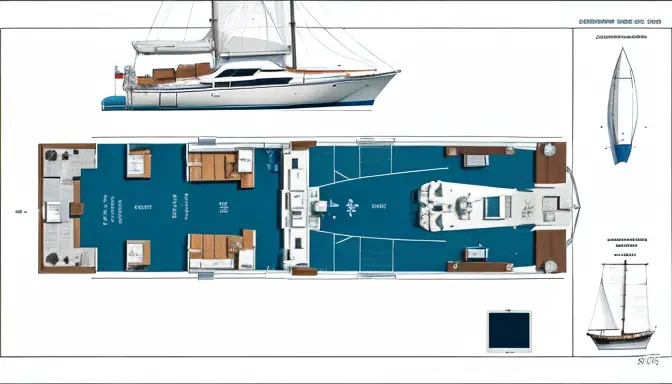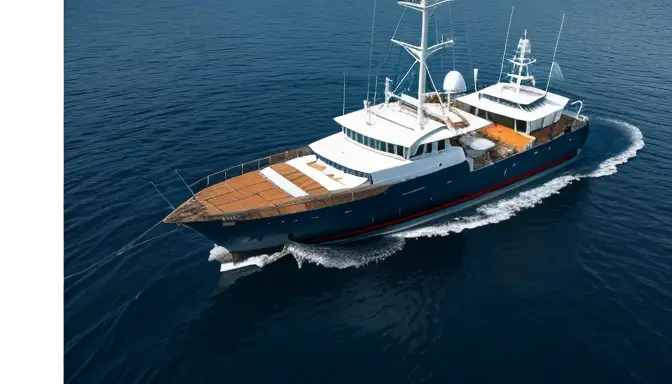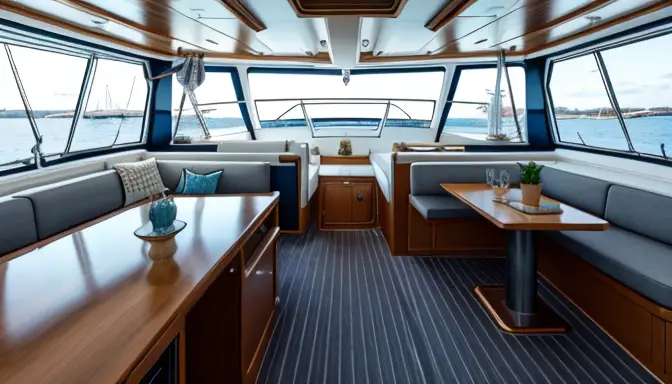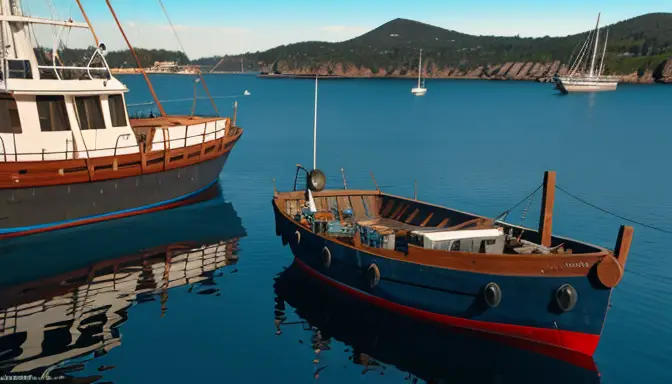Converting your sailboat into a trawler can be an exciting and rewarding project that opens up a whole new world of possibilities on the water. Before embarking on this transformation journey, it is essential to carefully assess your sailboat’s current state and features to determine its suitability for conversion. Factors such as size, hull design, and structural integrity play a crucial role in this evaluation process.
Once you have evaluated your sailboat and confirmed its potential for conversion, the next step is to meticulously plan out the conversion process. Creating a detailed conversion plan will help you outline the necessary modifications needed to turn your sailboat into a trawler. Consider aspects such as design elements, equipment upgrades, and budget constraints to ensure a smooth and successful conversion.
Structural modifications are a key aspect of converting a sailboat into a trawler. This may involve reinforcing the hull, adding a keel for stability, or modifying the deck layout to accommodate trawler features. These structural changes are essential to ensure the safety and functionality of your transformed vessel.
Installing the right trawler equipment is crucial for a successful conversion. From propulsion systems and navigation instruments to safety gear and amenities for extended cruising, each component plays a vital role in the overall functionality and comfort of your trawler. Understanding the essential equipment needed and installing them correctly is paramount.
Electrical and plumbing upgrades are another important consideration when converting your sailboat into a trawler. Upgrading the electrical system to support new trawler systems, installing a generator, and redesigning the water supply are all critical steps in ensuring the smooth operation of your vessel.
Interior and exterior refitting are the finishing touches that can greatly enhance the comfort and functionality of your trawler. Adjusting the cabin layout, implementing smart storage solutions, and making aesthetic improvements will not only improve the overall experience on board but also add a personal touch to your vessel.
Testing and sea trials are essential steps post-conversion to validate the safety, performance, and seaworthiness of your newly transformed trawler. Conducting thorough tests and trials will help identify any issues or areas that require further attention, ensuring that your vessel is ready for extended cruising adventures.
Finally, maintaining your trawler is key to keeping it in top condition for years to come. Implementing regular inspections, timely repairs, and adhering to a comprehensive servicing schedule will help prolong the life of your converted trawler and ensure that it continues to provide memorable experiences on the water.
Assessing Your Sailboat
Assessing your sailboat is a crucial first step in the conversion process. To determine if your sailboat is suitable for transformation into a trawler, you need to evaluate various aspects of its current state and features.
Here are some key factors to consider:
- Size: Assess the size of your sailboat to ensure it can accommodate the additional equipment and modifications required for a trawler.
- Hull Design: Evaluate the hull design to determine if it can support the structural changes needed for the conversion.
- Structural Integrity: Check the overall structural integrity of the sailboat to see if it can withstand the modifications and upgrades.
By thoroughly assessing these aspects, you can make an informed decision about the feasibility of converting your sailboat into a trawler.

Planning the Conversion
Planning the conversion of your sailboat into a trawler is a crucial step that requires meticulous attention to detail and careful consideration of various factors. To ensure a successful transformation, it’s essential to create a comprehensive plan that outlines the necessary modifications and upgrades. Here are some key points to consider:
- Evaluate Your Goals: Determine the primary purpose of converting your sailboat into a trawler. Are you looking to enhance comfort for long-distance cruising or improve fishing capabilities?
- Assess Budget Constraints: Set a realistic budget for the conversion project, taking into account the cost of materials, labor, and any unexpected expenses that may arise.
- Consult with Experts: Seek advice from marine engineers, naval architects, or experienced boat builders to help you create a detailed plan that meets your specific needs.
- Research Design Elements: Explore different trawler designs and layouts to determine the features that best suit your intended use and preferences.
By carefully planning the conversion process, you can ensure that your sailboat is transformed into a trawler that meets your requirements and provides a safe and enjoyable cruising experience.
Structural Modifications
When converting your sailboat into a trawler, structural modifications play a crucial role in ensuring the success of the transformation. Reinforcing the hull, adding a keel, and adjusting the deck layout are key elements to consider. Here are some important aspects to focus on during the structural modifications:
- Hull Reinforcement: Assess the strength of the hull and reinforce it as needed to support the additional weight and equipment of a trawler.
- Keel Addition: Consider adding a keel to improve stability and maneuverability, especially in rough waters.
- Deck Layout Modification: Modify the deck layout to accommodate trawler features such as fishing gear storage, winches, and additional equipment.
- Superstructure Changes: Evaluate the superstructure for any necessary modifications to enhance the overall functionality and aesthetics of the trawler.
By focusing on these structural modifications, you can ensure that your sailboat is successfully converted into a trawler that meets your needs and expectations.

Installing Trawler Equipment
When it comes to converting your sailboat into a trawler, installing the right equipment is crucial for a successful transformation. From propulsion systems to safety gear, each component plays a vital role in the functionality and efficiency of your newly converted vessel.
Here are some key considerations for installing trawler equipment:
- Propulsion Systems: Choose the appropriate propulsion system for your trawler, whether it’s a single engine, twin engines, or a hybrid setup. Consider factors like fuel efficiency, power output, and maneuverability.
- Navigation Instruments: Equip your trawler with essential navigation tools such as GPS, radar, depth sounders, and autopilot systems to ensure safe and accurate navigation on the water.
- Safety Gear: Prioritize safety by installing proper safety equipment including life jackets, fire extinguishers, distress signals, and emergency communication devices to handle any unforeseen situations.
- Amenities for Cruising: Enhance your trawler experience by adding amenities like a galley, sleeping quarters, bathroom facilities, and entertainment systems for comfortable and enjoyable extended cruising.
Electrical and Plumbing Upgrades
When it comes to converting your sailboat into a trawler, play a crucial role in ensuring the functionality and efficiency of your new vessel. Let’s delve into the essential modifications needed to support the systems of a trawler:
- Upgrading the Battery Bank: Installing a larger battery bank or upgrading to advanced batteries is essential to meet the increased power demands of trawler equipment.
- Installing a Generator: A reliable generator is necessary to provide continuous power supply for onboard systems and amenities during long cruises.
- Redesigning the Water Supply: Adapting the plumbing system to accommodate the water needs of a trawler, including freshwater storage, filtration, and distribution.
By focusing on these , you can ensure that your converted trawler is equipped with the necessary systems to support a comfortable and efficient cruising experience.

Interior and Exterior Refitting
When converting your sailboat into a trawler, the interior and exterior refitting process plays a crucial role in enhancing both comfort and functionality. To achieve a successful transformation, consider making adjustments to the cabin layout, implementing efficient storage solutions, and focusing on aesthetic improvements. By reimagining the interior space, you can create a more ergonomic and inviting environment for extended cruising.
Additionally, exterior refitting involves enhancing the visual appeal of your trawler while ensuring practicality. This may include updating the deck layout, improving access to essential equipment, and optimizing the overall design for efficiency. By paying attention to detail in both the interior and exterior aspects, you can elevate the overall experience of owning and operating a converted trawler.
Testing and Sea Trials
When it comes to converting your sailboat into a trawler, one crucial phase that cannot be overlooked is the testing and sea trials. These trials are the ultimate litmus test for the success of your conversion project, ensuring that your newly transformed trawler is safe, efficient, and seaworthy. But what exactly does this process entail?
First and foremost, before setting sail, it is essential to conduct thorough checks on all the structural modifications and installations made during the conversion. This includes inspecting the reinforced hull, keel additions, and any deck layout modifications to guarantee their integrity and functionality.
During sea trials, you will need to assess the performance of the trawler equipment, such as propulsion systems and navigation instruments. Are they operating smoothly and effectively? Are there any adjustments or fine-tuning needed to optimize their functionality?
Additionally, testing the electrical and plumbing upgrades is crucial to ensure that the new systems can support the demands of extended cruising. From the upgraded battery bank to the redesigned water supply, each component must be tested for reliability and efficiency.
Sea trials also provide an opportunity to evaluate the interior and exterior refitting of your trawler. Is the cabin layout ergonomic and comfortable? Are the storage solutions practical and accessible? These trials allow you to fine-tune the design elements for maximum functionality and aesthetics.
Lastly, conducting sea trials is not just about performance but also about safety. Testing the seaworthiness of your trawler in varying conditions will give you confidence in its ability to handle different scenarios at sea. It’s a chance to identify any potential weaknesses and address them before embarking on extended cruises.

Maintaining Your Trawler
When it comes to maintaining your trawler, consistency is key. Regular upkeep and care are essential to ensure your vessel remains in top condition for all your future seafaring adventures. Let’s dive into some important practices and tips to keep your converted trawler shipshape:
- Regular Inspections: Schedule routine inspections to check for any signs of wear and tear, leaks, or damage. Addressing issues promptly can prevent them from escalating into major problems.
- Fluid Checks: Keep a close eye on all fluid levels, including fuel, oil, and coolant. Maintaining proper levels and quality of fluids is crucial for the smooth operation of your trawler.
- Cleaning and Detailing: Regular cleaning of the interior and exterior surfaces not only keeps your trawler looking its best but also helps prevent corrosion and deterioration.
- Engine Maintenance: Follow the manufacturer’s guidelines for engine maintenance, including oil changes, filter replacements, and belt inspections. A well-maintained engine is essential for reliable performance.
- Hull Care: Check the hull for any signs of damage, fouling, or blistering. Proper hull maintenance, including cleaning and antifouling treatments, is crucial for optimal performance and fuel efficiency.
By incorporating these maintenance practices into your routine, you can ensure that your converted trawler remains in excellent condition and ready to take on the open seas with confidence.
Frequently Asked Questions
- Can any sailboat be converted into a trawler?
While many sailboats can be converted into trawlers, the feasibility depends on factors like the size of the boat, its hull design, and structural integrity. It’s essential to assess these aspects before proceeding with the conversion.
- What equipment is essential for a trawler conversion?
Key equipment for a trawler includes propulsion systems, navigation instruments, safety gear, and amenities for extended cruising. Understanding and installing these components are crucial for a successful conversion.
- How important are testing and sea trials post-conversion?
Conducting thorough testing and sea trials is vital to ensure the safety, performance, and seaworthiness of your converted trawler. These tests help identify any issues and ensure the vessel is ready for extended cruising.
- What Happened to Bluewater Yachts? The Inside Story - May 31, 2024
- Upgrade Your Boat’s Water Pump to the Mach 5 - May 30, 2024
- Upgrade Your Boat with the Big Stuff Stuffing Box - May 30, 2024


